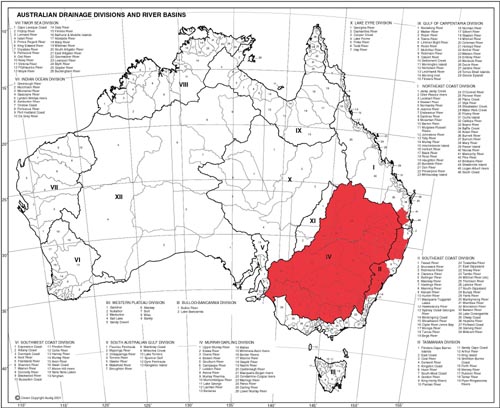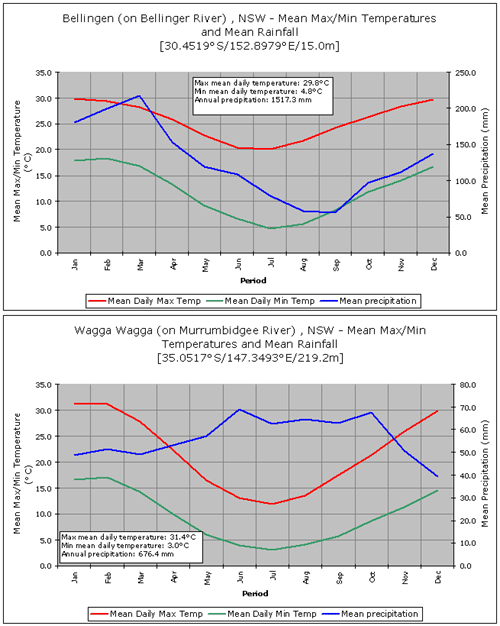Macquarie Turtle -- Emydura macquarii macquarii
[2]

Distribution
The subspecies E. macquarii macquarii inhabits
the Murray Darling Basin and some river basins of coastal New South Wales
and southeast Queensland. The Murrumbidgee River, Lachlan River, Namoi River,
Macquarie River, Murray River, Bellinger River, Clarence River, Macleay
River, Hunter River are a few of many rivers inhabited by the nominate species
of E. macquarii.
Right: Distribution map of E. m. macquarii
Natural habitat
The water bodies occupied by E. macquarii macquarii
include rivers, lakes, creeks, lagoons, and large waterholes. Generally
the species prefers slow moving or stagnant waters. Due to the large distribution
of the species, the climatic conditions that affect the areas inhabited
by the species vary from place to place. The Murray-Darling Basin, which
has the majority of E. macquarii macquarii populations within its
boundaries, provides different natural environments ranging from the rainforests
of the cool and humid eastern uplands through the temperate country of the
south-east to the subtropical areas of the northeast. The populations in
the river basins of coastal New South Wales, such as the Hawkesbury River
and Hunter River basins, have the temperate climate in the south turning
to the subtropical climate towards the south east Queensland (i.e. Brisbane
River basin).
The water temperature depends on the season as well as the location. Basically it ranges from 5°C (winter time in the south) to 30°C (summer in the north). The rivers of NSW tend to be alkaline with the pH between 6.5 and 9.0.
The different environment affects the species ecology. While the species is frequently seen basking on emergent logs or rocks in the south, I suspect aquatic basking is preferred by populations in the north (i.e. the Bellinger River).
Bottom graphs: Two examples of max/min temperatures and precipitation within the distribution of E. m. macquarii
 E. macquarii macquarii occurs in sympatry with Chelodina longicollis
and Macrochelodina expansa throughout most of the Murray-Darling
drainage. The species is probably also in sympatry with the southern populations
of Elseya latisternum (the Richmond River), with Elseya georgesi
(the Bellinger River), with Elseya purvisi (the Manning River)
and with Elseya belli (the Namoi and Gwydir Rivers).
E. macquarii macquarii occurs in sympatry with Chelodina longicollis
and Macrochelodina expansa throughout most of the Murray-Darling
drainage. The species is probably also in sympatry with the southern populations
of Elseya latisternum (the Richmond River), with Elseya georgesi
(the Bellinger River), with Elseya purvisi (the Manning River)
and with Elseya belli (the Namoi and Gwydir Rivers).
Diet
E. macquarii macquarii an opportunistic omnivore.
Its diet consists of filamentous algae, vertebrate carrion, detritus, periphyton,
aquatic insects, and aquatic plants (Chessman 1986). Other items, such as
carrion and invertebrates, are also eaten and appear to be essential dietary
items for this species, owing to its inability to meet its metabolic requirements
solely from macrophytes (Spencer et al. 1998). Cann (1998) states
the species eats acquatic plants, algae, insects, mollusks, yabbies, carrion,
and fish. Unlike the carnivorous members of Chelodina and Macrochelodina
genera, Emydura macquarii macquarii is most likely incapable of
catching live fish.
Spencer et al. (1998) studied the diet and digestive energetics
of Emydura macquarii macquarii and found out the majority of the
species' diet consisted of just two items, filamentous algae (53% by volume)
and carrion (Teleostomi) (21% by volume). The study included stomach contents
of 47 captured specimens, enough to come up with precise and reliable results.
It seems the E. macquarii macquarii is an Emydura species
with the biggest percentage of plant matter in its diet. Spencer et
al. (1998) compared the species diet to that of E. macquarii nigra,
the diet of which comprised only 30% of plant material. The Northern (tropical)
species of Emydura are also omnivores, but with the greater proportion
of animal material in their diet.
